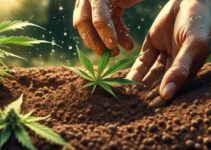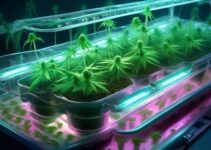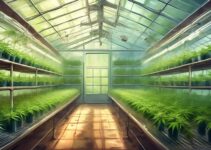You might have noticed that the role of dark phases in seed germination is often overlooked, but the truth is, they are crucial to the process. Understanding the key reasons why dark phases boost seed germination can provide valuable insights into optimizing the conditions for successful germination. From the intricate interplay of hormones to the breaking of dormancy, there are several compelling factors that shed light on the significance of darkness in the germination process. These reasons not only highlight the importance of dark phases but also offer a deeper understanding of the intricate mechanisms that drive seed germination.
Key Takeaways
- Phytochromes play a crucial role in seed germination by detecting red and far-red light.
- Dark-induced germination is essential for plant species in low light environments and allows for natural regeneration in shaded or underground areas.
- Light exclusion promotes gibberellic acid biosynthesis and regulates germination by repressing genes related to abscisic acid biosynthesis.
- Darkness promotes the breakdown of dormancy-maintaining hormones and creates an environment conducive to germination by stimulating germination-related gene expression.
Seed Dormancy and Dark Phases
Breaking seed dormancy through dark phases is a critical process in stimulating germination in many plant species. The influence of dark conditions on seed dormancy is a crucial factor in the germination process. Environmental factors such as light exposure play a significant role in the regulation of seed dormancy. In some cases, light exposure can inhibit germination, while darkness promotes it. Some seeds require a period of darkness to trigger germination, indicating the importance of dark phases in the life cycle of plants. Dark treatment can lead to the activation of specific enzymes that aid in the germination process, further emphasizing the role of darkness in seed dormancy and germination. Moreover, darkness can help synchronize germination in seeds that have varied germination requirements, ensuring a cohesive and efficient germination process. Understanding the intricate relationship between seed dormancy, environmental factors, and dark phases is essential for managing and promoting the germination of seeds, which ultimately influences weed and crop management.
Role of Phytochrome in Germination
The influence of dark conditions on seed dormancy is intricately connected to the role of phytochrome in regulating seed germination in many plant species. Phytochromes, which are sensitive to red and far-red light, play a pivotal role in the germination process. Red light promotes seed germination by stimulating the expression of genes involved in gibberellic acid (GA) biosynthesis and the breakdown of abscisic acid (ABA), a hormone that inhibits germination. Conversely, far-red light has the opposite effect, reversing the promotion of germination initiated by red light. Phytochromes act as primary sensors for light-regulated seed germination, integrating environmental light cues to modulate the balance between ABA and GA levels. This modulation is critical for seed viability and the timing of germination. Light requirements for seed germination are tightly regulated by phytochromes, and their role in mediating hormonal pathways underscores the significance of environmental light conditions in determining the fate of seeds. Understanding the intricate interplay between phytochrome signaling and hormonal regulation provides valuable insights into optimizing seed germination for agricultural and ecological applications.
Dark-Induced Seed Germination
Exposing seeds to darkness triggers the process of germination, known as dark-induced seed germination, which is essential for the successful establishment and growth of certain plant species in low light environments. Dark-induced seed germination is a crucial adaptive mechanism that allows seeds to overcome the inhibitory effects of light on germination. In environments where light may be limited, such as shaded or underground areas, dark-induced germination enables plant species to germinate and thrive. This process plays a pivotal role in the natural regeneration of plant populations in ecosystems with dense vegetation or low light penetration. By understanding the mechanisms underlying dark-induced seed germination, researchers and agricultural experts can optimize germination processes for diverse environmental conditions, including controlled environments with limited light exposure. Furthermore, the study of dark-induced germination provides valuable insights into the ecological strategies employed by plants to ensure their survival and propagation in challenging environmental settings. Overall, dark-induced seed germination is a fundamental process that allows plant species to adapt and thrive in low light conditions, contributing to the resilience and biodiversity of ecosystems.
Seed Germination and Light Exclusion
Light exclusion influences the expression of key genes involved in gibberellic acid biosynthesis, thereby promoting seed germination. Environmental factors, such as light availability, play a crucial role in regulating seed germination. When seeds are exposed to light, it triggers signaling pathways that can either promote or inhibit germination. In the case of light exclusion, it represses the expression of genes related to abscisic acid biosynthesis, which is responsible for inducing seed dormancy. Additionally, phytochromes, the primary light sensors in plants, are influenced by light exclusion, impacting their regulatory role in seed germination. This response to light exclusion can be particularly significant in weed management strategies, as it can affect the germination rates of weed seeds. Understanding the intricate interplay between light exclusion and seed germination at a molecular level provides valuable insights for agricultural practices and ecosystem management. By manipulating light exposure, it is possible to modulate germination processes, potentially improving crop yields and optimizing weed control measures.
Importance of Dark Period for Seeds
Influencing gene expression related to gibberellic acid biosynthesis, light exclusion significantly impacts seed germination, but equally important is the role of darkness in promoting the breakdown of dormancy-maintaining hormones and stimulating the expression of genes crucial for germination. The importance of dark periods for seeds can't be overstated. Here's why it matters:
- Breakdown of Dormancy: Darkness plays a vital role in promoting the breakdown of abscisic acid (ABA), a hormone that maintains seed dormancy. This breakdown is essential for the initiation of the germination process.
- Seed Coat: In the absence of light, the seed coat perceives the darkness, triggering a cascade of events that lead to the degradation of ABA, allowing the seed to advance towards germination.
- Stimulation of Germination-Related Genes: Dark periods stimulate the expression of genes crucial for germination. These genes are responsible for initiating the metabolic processes necessary for germination to occur, providing the energy and nutrients required for the seed to emerge from dormancy and begin growth.
- Low Temperatures and Moisture Levels: The absence of light, combined with optimal low temperatures and moisture levels, creates an environment conducive to the expression of these genes and subsequent germination.
Phytochrome and Seed Germination
Phytochromes, as light-sensitive proteins, play a crucial role in the activation of seed germination. They serve as the primary sensors for light-regulated seed germination, with red light promoting germination and far-red light reversing it. The intricate interplay between phytochrome-mediated light signaling and the regulation of ABA and GA hormones is central to the process of seed development and germination.
Phytochrome and Germination
How does phytochrome signaling interact with the hormone regulation to control the process of seed germination?
- Phytochrome Signaling and Hormone Regulation:
- Phytochromes detect red and far-red light to regulate seed germination.
- Red light activates phytochromes, promoting germination by inhibiting ABA and activating GA biosynthesis.
Phytochrome signaling plays a crucial role in the regulation of seed germination. When seeds are exposed to red light, phytochromes are activated, which in turn inhibits the production of abscisic acid (ABA) and promotes the synthesis of gibberellic acid (GA). This process effectively reduces seed dormancy and enhances the germination rate. Furthermore, phytochrome signaling influences the expression of genes responsible for ABA and GA biosynthesis, ultimately impacting the balance between dormancy and germination. Additionally, environmental factors such as temperature and moisture also interact with phytochrome signaling to ensure optimal conditions for seedlings to emerge.
Light-Sensitive Seed Activation
Light sensitivity plays a critical role in the activation of seed germination, involving the intricate interplay between phytochromes and hormonal regulation. Phytochromes are the primary sensors for light-regulated seed germination. Red light promotes seed germination, while far-red light reverses it, demonstrating the pivotal role of light in this process. Additionally, light induces the expression of genes involved in gibberellic acid (GA) biosynthesis and abscisic acid (ABA) catabolism, while repressing genes responsible for ABA biosynthesis and GA catabolism. This intricate regulation by light influences the balance between GA and ABA, crucial hormonal regulators of seed germination. Understanding the mechanisms by which environmental factors, particularly light, influence seed germination through phytochrome-mediated pathways is essential for comprehending seed responses to their surroundings and the initiation of the germination process.
Role in Seed Development
The regulation of seed germination by phytochromes and specific hormones like abscisic acid (ABA) and gibberellic acid (GA) is a crucial aspect of seed development. Phytochromes serve as the primary sensors for light-regulated seed germination, playing a pivotal role in the transition from dormancy to germination. The interplay between light and these hormones determines the fate of seed germination, with ABA maintaining dormancy under unfavorable conditions, while GA promotes germination in response to favorable environmental cues. Light, especially red light, induces the expression of GA biosynthetic genes and represses ABA biosynthetic genes, thereby boosting seed germination. This intricate regulatory network highlights the significance of phytochromes and specific hormones in orchestrating the complex process of seed development.
Regulation of Seed Germination by Darkness
In the regulation of seed germination by darkness, it is essential to understand the contrasting effects of light and darkness on this process. Dark conditions trigger germination by promoting the breakdown of dormancy and stimulating the expression of germination-related genes. Conversely, light inhibits germination by maintaining dormancy and suppressing the expression of genes essential for germination.
Dark Triggers Germination
Darkness plays a crucial role in triggering the germination of seeds in certain plant species, inhibiting the expression of ABA biosynthetic genes and GA catabolic genes, thus promoting the germination process. This regulation by darkness is essential for the successful emergence of seedlings. Factors affecting seed germination, such as temperatures and seed quality, are directly influenced by dark triggers for germination. Understanding the intricate relationship between darkness and seed germination provides valuable insights for optimizing germination conditions in plant cultivation. Additionally, dark conditions can reverse the suppression of seed germination induced by far-red light, indicating the intricate interplay between light and darkness in the regulation of germination. Phytochromes, the primary light sensors, are involved in light-regulated germination, further underscoring the significance of darkness in the germination process.
- Regulation by darkness is essential for the successful emergence of seedlings.
- Factors affecting seed germination, such as temperatures and seed quality, are directly influenced by dark triggers for germination.
Light Inhibits Germination
By inhibiting the expression of ABA biosynthetic genes and GA catabolic genes, darkness plays a fundamental role in promoting seed germination, setting the stage for understanding the contrasting effects of light in the regulation of this critical process. In contrast to darkness, light inhibits germination by repressing the expression of ABA catabolic genes and GA biosynthetic genes. Phytochromes serve as the primary sensors for light-regulated seed germination. Light induces the expression of GA biosynthetic genes and an ABA catabolic gene, which promotes seed germination. Additionally, it is important to note that far-red light can reverse the promotion of seed germination by red light. Understanding the precise mechanisms by which light inhibits germination is crucial for optimizing conditions for seedling emergence and growth in agricultural and ecological settings.
Dark-Responsive Germination Pathways
During the initial stages of seed imbibition in the absence of light, crucial regulatory pathways are activated to promote germination. Dark-responsive germination pathways play a pivotal role in the environmental regulation of seed germination. Here are some key points to consider:
- Phy-mediated Light Signaling: In the absence of light, phy-mediated light signaling is suppressed, leading to the activation of dark-responsive pathways that promote germination.
- Upregulation of GA Biosynthetic Genes: The decrease in ABA levels and the upregulation of gibberellic acid (GA) biosynthetic genes occur during early seed imbibition in dark conditions, promoting germination and seedling growth.
- Low Temperature and Chilling: Dark phases, especially in low temperature and chilling conditions, can release seeds from dormancy and synchronize germination. This synchronization is critical for the successful establishment of plants in the environment.
These dark-responsive pathways are essential for seed germination in the absence of light and highlight the intricate environmental regulation of this critical stage in a plant's life cycle.
Seed Germination and Light Inhibition
Light is a critical environmental factor that influences seed germination, with specific wavelengths either promoting or inhibiting the process. Phytochromes, as the primary light sensors, play a key role in regulating seed germination in response to light signals. Understanding the intricate mechanisms by which light inhibits germination is essential for developing strategies to optimize seedling growth and overall crop yield.
Light and Germination
Influencing the germination process, light plays a crucial role in seed germination, with its impact differing based on the specific wavelengths present.
- Light quality and quantity are critical factors influencing seed germination.
- Red light promotes germination, while far-red light inhibits it.
- Phytochromes, the photoreceptors, are crucial for light-regulated seed germination, perceiving red and far-red light.
- Light induces the expression of genes promoting germination and represses genes related to dormancy, regulating the germination process. Understanding the role of light in seed germination is essential for optimizing germination conditions. Light serves as an environmental trigger, influencing the germination process, along with factors such as temperature and moisture.
Dark and Seedlings
Dark phases are crucial for promoting the initiation of the germination process in seeds, facilitating the breakdown of dormancy and the activation of growth processes. During these dark phases, light inhibition plays a vital role in regulating seed germination, preventing premature germination in unfavorable conditions. The absence of light stimulates the expression of genes related to seed germination, promoting the breakdown of dormancy and the initiation of growth. This process is essential for managing the weed seed bank and ensuring that seeds germinate under favorable conditions. Darkness triggers biochemical changes in seeds, promoting the activation of growth processes and metabolic activity. It provides an essential environmental cue for seed germination, influencing the timing and efficiency of the germination process, especially in the presence of adequate moisture.
Dark-Induced Germination Mechanisms
The absence of light triggers a cascade of molecular and hormonal responses within seeds, initiating the process of germination through specific genetic pathways. Dark-induced germination mechanisms involve intricate processes that are vital for seedling development. Here are the key mechanisms involved:
- Regulation of Gibberellic Acid (GA) Biosynthesis:
- Darkness triggers the upregulation of genes involved in GA biosynthesis, which is essential for breaking seed dormancy and promoting germination.
- Suppression of Abscisic Acid (ABA) Biosynthesis:
- Dark-induced germination involves the suppression of genes related to ABA biosynthesis. ABA maintains seed dormancy, and its suppression releases dormancy, promoting germination.
These mechanisms are crucial for seed germination in the absence of light. Furthermore, dark phases also influence the uptake of carbon dioxide and the regulation of soil moisture, contributing to the overall process of germination. The intricate interplay of molecular and hormonal responses to darkness underscores the significance of dark-induced germination mechanisms in the lifecycle of plants.
Dark Phase Signaling in Seed Germination
By orchestrating the expression of specific genes, dark phase signaling significantly impacts the regulation of seed germination, particularly in relation to the antagonistic interplay between abscisic acid (ABA) and gibberellic acid (GA). This signaling pathway is crucial for breaking seed dormancy and initiating the germination process. Dark phase signaling in seed germination is influenced by various factors, including temperature and the moisture content of the seeds. Understanding the intricate mechanisms of dark phase signaling is essential for optimizing seed germination conditions.
| Factors | Impact on Seed Germination |
|---|---|
| Light | Inhibits germination |
| Temperature | Influences germination rates |
| Moisture content | Affects seed dormancy and germination |
Dark phase signaling in seed germination is particularly important for the germination of dry seeds, as it serves as a trigger for the expression of specific genes that promote the breakdown of stored nutrients and the initiation of growth processes. It is through this signaling pathway that seeds can sense the optimal conditions for germination, ensuring the successful emergence of new plants.
Seed Dormancy Breakage in Darkness
Breaking seed dormancy and initiating the germination process is a complex biological phenomenon influenced by various environmental factors, such as temperature and moisture content. When it comes to seed dormancy breakage, darkness plays a crucial role in promoting germination. This occurs through intricate molecular pathways and signaling mechanisms. The following factors contribute to the seed dormancy breakage in darkness:
- Decreased Levels of ABA: Darkness results in decreased levels of abscisic acid (ABA), a hormone that maintains seed dormancy. This reduction in ABA levels is essential for initiating the germination process.
- *ABA Biosynthetic Gene Repression*: Darkness represses the expression of ABA biosynthetic genes, contributing to the breakdown of dormancy-related factors.
- Increased Expression of GA Biosynthetic Genes: Darkness leads to increased expression of gibberellic acid (GA) biosynthetic genes, which are involved in promoting seed germination.
- *Inhibition of Phy-Mediated Light Signaling*: Darkness inhibits phy-mediated light signaling, allowing for the release of seeds from dormancy.
These interconnected molecular events highlight the significance of darkness in breaking seed dormancy and facilitating the subsequent germination process.
Dark Treatment and Germination Enhancement
Enhancing seed germination through dark treatment involves creating an optimal environment for imbibition and initiation of the germination process. Dark treatment promotes germination by triggering the breakdown of abscisic acid (ABA) levels and the upregulation of gibberellic acid (GA) biosynthetic genes during early seed imbibition. This process is essential for breaking dormancy and initiating germination in seeds requiring physiological dormancy. Dark treatment is particularly beneficial for seeds needing cold treatment to synchronize and promote germination. By providing the necessary conditions for seed imbibition and early growth, dark treatment supports metabolic activation and cell division crucial for successful germination.
| Dark Treatment Benefits | Examples |
|---|---|
| Triggers ABA breakdown and GA biosynthesis | Seeds with physiological dormancy |
| Synchronizes and promotes germination | Seeds requiring cold treatment for dormancy release |
| Provides optimal conditions for imbibition | Seeds with deep complex dormancy |
| Supports metabolic activation and cell division | Seeds with slow germination response |
Dark treatment plays a crucial role in enhancing seed germination by creating a conducive environment for the early stages of germination, particularly for seeds with different dormancy types and germination responses.
Dark Phase Stimulation of Seedling Growth
You can now explore the impact of dark phase stimulation on seedling growth. This process is crucial for initiating the development of roots and shoots after the seed has germinated. Through the activation of enzymes and cell division, dark conditions play a vital role in promoting the metabolism and sequential formation of leaves, nodes, and internodes in seedlings.
Growth in Darkness
The stimulation of seedling growth in darkness is mediated by specific gene expression, enzymatic activity, and the inhibition of certain inhibitors, facilitating the successful initiation of germination and early growth processes. When seeds are in the dark, several factors contribute to their growth:
- Enhanced Enzymatic Activity
- Darkness triggers the activation of enzymes responsible for breaking down stored nutrients, providing the necessary energy for seedling growth.
- Temperature Regulation
- Dark conditions often maintain a stable temperature, which is favorable for seed germination and early growth processes. Optimal temperatures can significantly increase germination percentages.
Growth in darkness provides an environment conducive to the initial phases of seed germination and seedling growth, highlighting the critical role of this environmental factor in the early stages of plant development.
Seedling Development
During the dark phase, seedling growth is stimulated by promoting elongation and cell division in the embryo. Reserve foods sustain the growing embryo until leaves expand and roots develop. Sequential formation of leaves, nodes, and internodes occurs from shoot apices in response to the dark phase. Shoots may originate from apical meristems in leaf axils, providing branches to the young plant during seedling growth. Optimal temperatures for seedling growth may differ from germination temperatures, influencing the dark phase stimulation of seedling growth.
| Seedling Development | Benefits |
|---|---|
| Seed Vigor | Increased |
| Root Development | Enhanced |
| Moist Paper Towel | Facilitates Growth |
The dark phase not only promotes germination but also ensures robust seedling development, leading to healthy and vigorous plants.
Dark Phase Benefits
Indisputably, the dark phase significantly enhances seed germination by promoting vital physiological processes. This phase benefits seeds in the soil by breaking dormancy and aiding in the regulation of ABA levels, a crucial factor in seed dormancy. Moreover, the absence of light during the dark phase can enhance the expression of genes that promote germination, countering the inhibitory effects of light. Additionally, the dark phase provides the optimal temperature for seed germination, promoting the emergence of seedlings. It also supports the sequential formation of leaves, nodes, and internodes during seedling growth. These combined effects illustrate the importance of the dark phase in promoting seed germination and early seedling development.
Dark Period Effects on Seed Viability
In the context of seed germination, the presence of dark periods significantly influences the viability and success of the germination process. Dark period effects on seed viability are crucial for the initiation and maintenance of germination. During dark phases, various physiological and biochemical processes are triggered, leading to enhanced seed viability. The absence of light stimulates the reduction of abscisic acid (ABA) levels, which is essential for breaking seed dormancy and promoting germination. Additionally, dark phases prevent the reversal of germination caused by far-red light, ensuring consistent and successful germination.
Optimal conditions for germination, such as water uptake and hormone regulation, are facilitated during dark periods, further promoting seed viability. Dark phases also serve as an environmental trigger for the expression of genes associated with seed germination, contributing to the overall success of the germination process. Understanding the impact of dark periods on seed viability is crucial for optimizing germination conditions, particularly considering the influence of temperatures for seed germination and the need for consistent and reliable outcomes in agricultural and ecological contexts.
Frequently Asked Questions
Why Is Darkness Important for Seed Germination?
Why is darkness important for seed germination? Darkness is vital because it triggers the release of ABA, promotes the release of gibberellic acid, breaks seed dormancy, synchronizes germination, and enables effective water absorption and enzyme activation.
What Are the 4 Factors That Triggers Seed Germination?
To trigger seed germination, temperature regulation, moisture content, oxygen intake, hormonal balance, and light exposure are crucial. These factors influence the activation of enzymes, metabolic processes, and the transition from dormancy to seedling growth.
What Are the 4 Key Environmental Factors Necessary for a Seed to Germinate?
To germinate, seeds need optimal temperature, moisture, oxygen in soil, and the absence of germination inhibitors caused by light exposure. Seed dormancy is broken, initiating the germination process, leading to improved viability and germination rates.
What Are 2 Important Factors Necessary for a Seed to Germinate?
To germinate, seeds need water for hydration and temperature around 25-30°C. Oxygen is necessary for growth and metabolism. Excluding light aids in germination. Hormones and genetic factors also play a significant role.





